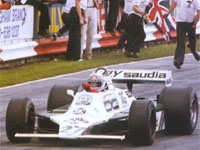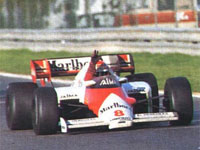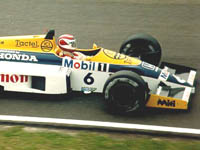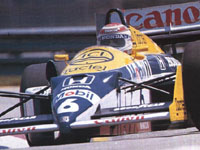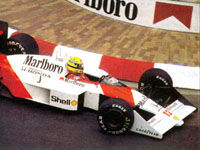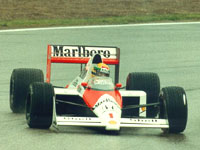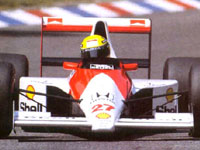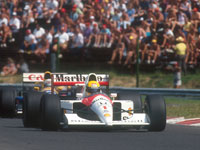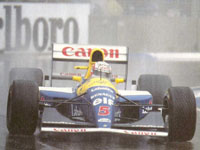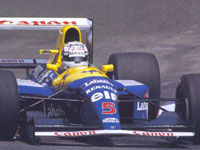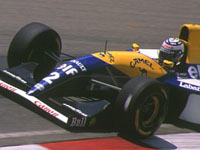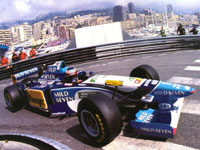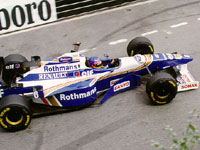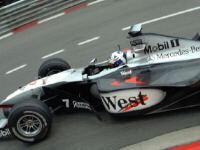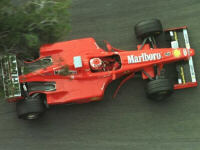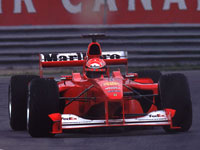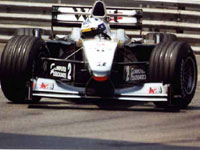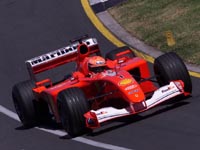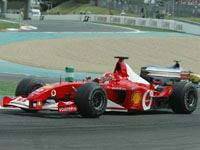The dominators
Modern-day F1 cars that ruled the roost
Author
- Henri Greuter
Date
- November 10, 2009
Related articles
- Second life - Identity changes in Grand Prix racing, by Mattijs Diepraam
- Defining moments in Grand Prix history - The events that determined what F1 looks like today, by Mattijs Diepraam
Who?Ayrton Senna, Alain Prost What?McLaren-Honda MP4/4 Where?Estoril When?XIII Portuguese GP (September 25, 1988) |
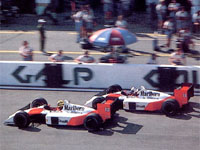 |
Why?
The foundations of this article were laid down when I first read complaints about Ferrari's F1 car during the 2002 Grand Prix season. Its first version was indeed written back in 2002.
Why? Because I became rather angry during 2002. The longer the season continued the more complaints I noticed about Ferrari dominating the season to the effect it became boring.
Well, Iím from 1961 and have been following F1 for a long time. Maybe it's because I have a soft spot for Ferrari that I didnít particularly object to their so-called domination. The other reason is that I remember a number of seasons in which one team completely overwhelmed the opposition. So was this Ferrari domination anything new and of proportions hitherto unseen, as some suggested? In fact so unseen that, unlike in previous years, it became boring to watch?
Let's put one complaint to rest with some bare facts right away: of the 15 constructor titles for grabs between 1984 and 1998. 14 went to either Williams or McLaren. The one they missed went to Benetton in 1995. However, Benetton used the same brand of engine that propelled Williams to the 1992-1994 and 1996-1997 titles. So that's five out of six for Williams-Renault between 1992-1997 while McLaren-Honda scored four constructor titles between 1988 and 1991, in addition to the driver titles they amassed. As for engine manufacturers, Honda had six titles in a row from 1986 to 1991 while Renault had a straight six from 1992 to 1997. During 2002 Ferrariís engine department was still three down on equalling that performance.
As for driver titles: 13 out of 15 titles were won by McLaren or Williams drivers between 1984 and 1998, with the remaining two going to Schumacher at Benetton. So the situation in 2002 was that since Ferrari came to power (letís say in 1999) they hadnít yet managed to better one of Williams's or McLaren's achievements. Between 1999 and 2002 Ferrari tied the four consecutive constructor titles of McLaren (1988-1991) but in 1999 it was still a McLaren-equipped Mika Hškkinen who was the champion. This meant that in 2002 the four consecutive driver titles was still a record held by McLaren.
Back in 2002 I felt there hadn't been much complaining about all this McLaren and Williams domination since four drivers had been fighting over the driver's title:
- Alain Prost - not the most popular driver but still well-respected by many
- Ayrton Senna - couldnít do anything wrong with the majority of fans worldwide, even when he did
- Nigel Mansell - the all-time British under(bull)dog
- Damon Hill - like-father-like-son sentiments and another Brit
As long as the dominating team had any of these drivers in their line-up the domination was deemed acceptable.
Still, all of that doesnít take away from the fact that in the 15 years from 1984 to 1998 90% of all F1 titles went to McLaren and Williams and their engine partners, with few, if any complaints about this being boring.
So, during the summer of 2002 I began to wonder which cars had been utterly dominant in their years. The first one coming to mind was the 1988 McLaren followed by the 1992 and 1993 Williams cars, but then the question arose whether Ferrari really did so much better in 2002 than any of those earlier all-conquering cars? And could the facts prove or disprove that it did?
This meant digging up the F1 annuals to find out what cars could be called F1 Ďdominatorsí. To then have cars qualify for this distinction I initially came up with the following requirements:
1. A victory rate of at least 50%. So 8 out of 16 would be enough, 8 out of 17 wouldn't.
2. A points tally of at least 50% of the maximum possible amount of points plus 1 point over a full season. So if a car started 16 races the maximum score would be for 16 one-twos. The car qualified as a dominator if it scored at least half of this amount, plus one.
The maximum points score was adjusted accordingly in case of races in which only half points were awarded (the rain-affected races at Monaco in Ď84 and Adelaide in Ď91) or a team entering a single car or having to withdraw an injured driver after qualifying. (This all happened to Williams on occasion.) Points weren't returned in case drivers were disqualified. Instead I would score the car as a DNF with no laps driven in the race.
I selected the modern F1 era that started in 1980. After that, a greater variety of factory engines came into play, which led to dominating cars often being the result of a perfect gelling between chassis and factory-supplied engine. Another reason to select the post-1980 era is that constructor points could be scored by both cars instead of only the best score being taken. Then, for a fair comparison, all Ďdominatorsí that received 9 points for a race victory instead of the 10 points introduced in 1991 had their scores modified to the 10-6-4-3-2-1 score.
I also restricted myself to nominating cars during a single season. Earlier versions used in previous seasons or updates issued in the following season are discarded and not included in the results for a certain type of car. This means for example that several Williamses and McLaren B, C and other specifications aren't combined but instead evaluated separately.
I was startled by the results. I thought my two requirements would be fairly tough to meet but it seemed that I had overlooked one thing. Ever since 1984, a car's season-long domination has been enhanced by ever increasing reliability and exclusive engine deals. McLaren and Williams earned their impression of dominating not just by their outright speed but with high reliability rates as well. Much to my surprise, my criteria weren't strict enough to prevent two cars from being dominators in the same season. This happened to be the case in no less than three seasons! At the same time, other cars were eventually scrapped from the list despite qualifying.
The first Ďdominatorí was the 1980 Williams FW07B. The car marks the end of an era in which one Cosworth kit-car could be dominating the other Cosworth-powered cars and other rivals.
Next is the 1984 McLaren-TAG, type MP4/2. Some might argue that the MP4/2 scores for the 1985 (MP4/2B) and 1986 (MP4/2C) versions have to be included as well but I disagree. These cars are too much of an update to be called the same car.
Both versions of the Williams-Honda FW11 used in 1986 and 1987 made the list handsomely.
The 1988, 1989 and 1991 McLaren-Hondas easily made the list, the 1990 car however at the skin of its teeth. From a maximum of 240 points it scored 121 points, so exactly the minimum required 50% + 1 point. In fact, if the 1990 winners had scored 10 points instead of 9 it would have missed the list by two points. The 1990 car might have qualified more easily if, at Suzuka, Ayrton Senna hadn'tÖ
The record of the 1988 MP4/4 is almost beyond belief. More on that very special car later on. Nevertheless, we shall see that Ayrton Senna, Nigel Mansell, Alain Prost, Damon Hill and Michael Schumacher all set some F1 records without the need of a MP4/4.
1991 is a strange year: two cars made the list since both the McLaren MP4/6 and the Williams-Renault scored over 50% plus 1 point. Although the Williams lost out to the McLaren, its performance outdid some of the figures of the 1990 McLaren that made the list, and so I decided to accept both. It's the same reason why both the 1998 and 2000 McLarens and Ferraris are on the list as well.
The unluckiest car that failed to make the list was the 1999 Ferrari. Despite scoring a mere 6 victories, two short of the required 8, it scored 128 points out of a possible 256: exactly 50%, so 1 point short!
The 1997 Williams was unlucky as well, with 8 victories in a 17-race season. It also scored a little over 47% of its maximum points tally so in every way it was a matter of close but no cigar. Equally, the 1999 McLaren came up short, missing the list by one victory and a couple of points.
One particular car was very controversial. The Benetton B194 qualified because of winning 8 of 16 races but it was also disqualified twice, losing a first and a second place. This saw Benetton lose more points than Schumacher's combined team mates Lehto, Verstappen and Herbert managed together! Also, if Senna hadn't been killed, how many of its 6 post-Senna victories would it have retained? Then again, what if Michael had been able to keep the places lost by being disqualified and what if he hadn't been suspended for two races? Add the fact that there's always been talk about the B194's supposedly illegal software options, and I had enough reason to ban the B194 from the list. Just too many ifs and buts.
The 1994 Williams came very close as well. It scored nearly 50% of its points maximum and might have earned the dominator title if Senna hadn't been killed. But it also inherited points from Schumacher's disqualifications and Hill won the two events from which Schumacher was banned. So it was a case of what might have been for the best two cars of 1994.
The Benetton B195, however, made it handsomely, even after losing 10 points through a fuel irregularity. Its 11 victories nailed it, even though had only one point to spare.
The 2000 McLaren also lost 10 constructor points but had points to spare and still beat the 50% plus 1 point entry level.
Another complicated car was the car that started off this project: the 2002 Ferrari. It didnít contest the full season but adding the 2002 results of the F2001 would be an insult. So the results for the F2002 are based on the 29 races it qualified for, and it didnít even start all of thoseÖ
And so the list of F1's post-1980 dominators initially looked like this:
A comparison table of all 19 dominators... (Excel file, 22k)
That makes 19 cars and a reject. Obviously, this list needed some trimming to select the true masters. The first question to solve was how two cars can be dominators in the same season?
So I raised the bar. Now, a car had to comply to both demands: 50% of its GPs won and 50% + 1 of its maximum score. This eliminated the 1980 Williams, the 1990 McLaren, the 1991 Williams, the 1998 Ferrari and the 2000 McLaren. We were now down to 14.
The second elimination contest needed some maths: cars had to score either 9 victories in a season or take at least 54.6 % of their maximum points. 54.6 may look like a strange value but it is the average of the following calculation:
{ [ ( 9 / 16) + ( 9 / 17 ) ] / 2 } x 100 %
I could have ignored this elimination round since none of the remaining cars was taken off the list. Only when cars had to meet both demands the 1991 McLaren and the 1995 Benetton fell off, the 10 points lost through that disqualification taking care of it for the latter. This still left 12 dominators. Further narrowing down the list seemed like an impossible task, so it was time for a change in strategy: I decided to select the top 5 in the following categories:
- A. Number of Grand Prix victories
- B. Number of doubles
- C. Highest percentage of maximum points score
I considered all cars making it into the top 5 in each of these categories the genuine F1 dominators. This was the score:
A. GP winners
1. 1988 McLaren (15)
2. 2002 Ferrari (14)
3= 1984 McLaren (12)
3= 1996 Williams (12)
5. 1995 Benetton (11)
B. Double victories
1. 1988 McLaren (10)
2. 2002 Ferrari (9)
3= 1992 Williams (6)
3= 1996 Williams (6)
5. 1998 McLaren (5)
C. Highest percentage maximum score
1. 2002 Ferrari (88.46%)
2. 1988 McLaren (83.59%)
3. 1996 Williams (68.36%)
4. 2001 Ferrari (65.81%)
5. 1993 Williams (65.63%)
What truly surprised me was that both the 1992 and 1993 Williamses managed to make just one of these top-5 scores each! Most remember 1992 and 1993 for their overwhelming superiority but the bare results and statistics compared to other cars donít show this.
The presence of the 2002 Ferrari on these lists eliminated a number of joint fifth scores for both GP victories and double victories, pushing the 1992 Williams to the 6th highest percentage of its maximum points score. That eventually cost the 1992 Williams a top-5 spot in all three of these criteria. And so, here is our list of genuine post-1980 F1 dominators from the period of 1980-2002.
- 1988 McLaren-Honda MP4/4
- 1996 Williams-Renault FW18
- 2002 Ferrari F2002
Then came 2004 and the Ferrari F2004.
The F2004 came close to breaking just about every record in the book but in the last four races of its career it performed less well, thereby failing to take the top spots in all of the above categories after all. Despite that, it scored 15 victories (joint first with the MP4/4), 8 double victories (third behind the MP4/4 and the F2002) and 79.19% of its maximum possible points score (again third in class).
It's interesting to point out that the F2004's averages would have improved if the last race of the season hadn't taken place. Nevertheless, the car joined our initial trio of dominators handsomely, making our group of F1 dominators into a quartet:
- 1988 McLaren-Honda MP4/4
- 1996 Williams-Renault FW18
- 2002 Ferrari F2002
- 2004 Ferrari F2004
Here's a statistics overview for these 'stars among the F1 cars'. Please keep in mind that the MP4/4 and F2004 raced under different points systems, so I used the 10-6-4-3-2-1 system for all cars.
| 1988 MP4/4 | 1996 FW18 | 2002 F2002 | 2004 F2004 | |
| Qualifying positions | ||||
| 1st | 15 | 12 | 8 | 12 |
| 2nd | 12 | 13 | 10 | 8 |
| 3rd | 3 | 4 | 8 | 2 |
| 4td | 1 | 2 | 3 | |
| 5th | 1 | |||
| 6th | 2 | 4 | ||
| 7th or higher | 1 | 1 | 7 | |
| Starts | 32 | 32 | 29 | 36 |
| Two cars on front row | 12 | 9 | 5 | 4 |
| Neither car on front row | 1 | 2 | 2 | |
| Race results | ||||
| 1st | 15 | 12 | 14 | 15 |
| 2nd | 10 | 7 | 10 | 9 |
| 3rd | 2 | 1 | 5 | |
| 4th | 1 | 1 | 1 | 1 |
| 5th | 1 | |||
| 6th | 1 | 1 | ||
| 7th or lower | 2 | 1 | 3 | |
| Classified | 27 | 25 | 27 | 34 |
| DNF/NC/DSQ | 5 | 7 | 2 | 2 |
| Total number of races | 32 | 32 | 29 | 36 |
| Double victories | 10 | 6 | 9 | 8 |
| Points | 214 | 175 | 207 | 228 |
| Maximum possible points | 256 | 256 | 234* | 288 |
| Points percentage | 83.59 | 68.36 | 88.46 | 79.17 |
| Average points-per-start | 6.69 | 5.47 | 7.14 | 6.33 |
| Laps covered | 1930 | 1778 | 1743 | 2196 |
| Maximum laps in season | 2062 | 2028 | 1881 | 2244 |
| Reliability percentage | 93.60 | 87.67 | 92.66 | 97.86 |
* Two F2002s were used in 14 races, one car started a single race so the maximum score for the F2002 was (14 x 16) + 10 = 234 points
The dominators in qualifying
Since no points are awarded for qualifying I avoided taking those results into the evaluation. But in that respect the MP4 stands up to the very best as well.
The MP4 is one of four cars scoring 15 poles, meaning that it missed out on one pole position all season, with the 1989 McLaren, 1992 and 1993 Williams matching that feat. The tie-breaker is the number of second places on the grid. The 1993 Williams tops the 12 scored by the MP4 with 13. So at last, the MP4/4 is second best at something!
Both the MP4/4 and the 1989 MP4/5 Macs have 12 second grid places each. The MP4/4 and the 1993 Williams both had both cars on the front row 12 times.
Possibly the MP4/4ís worst record is that on one occasion it failed to get a single car on the front row. The 1989 McLaren and the 1992, 1993 and 1996 Williams all had at least one car at the front row every race. So if it comes to the amount of missed front rows: MP4/4 is only fifth best there.
Any other weaknesses? Maybe that on one occasion one car qualified 7th, while the 1993 Williams's worst qualifying effort is a 6th place, all others were on the first two rows. The 1992 Williams never qualified any lower than 4th although that car has 'only' 28 top-three starts while the 1993 Williams has 29, with (here we go again) the MP4/4 topping the list with 30 top-three qualifications.
So who are the ultimate qualifying kings and their cars?
It ainít Ayrton Senna! Nigel Mansell scored 14 poles in 1992, one better than Senna in Ď88 and Ď89. Nigelís other two grid positions were a second and a third. But letís call this contest a dead heat between Nigel in 1992, Alain Prost in 1993 and Senna in 1989. Alain and Ayrton scored 13 poles and three second places those years, meaning that they started every race from the front row.
The 1996 Williams plays second fiddle to all of these 1988 and 1989 McLaren qualifying achievements, but also to its Williams predecessors of 1992 and 1993. But 12 poles give it joint fifth on the list with the 1987 Williams, the 1990 and 1998 McLaren and the 2000 Ferrari. It wins the tie-break because of 13 second spots while in addition there was always at least one 1996 Williams on the front row, precisely one of the few achievements the MP4/4 failed to deliver.
The 2002 Ferrari is a rather poor contender in this category, even keeping in mind that it did three starts less than the MP4/4 and five less compared to the FW18. Even the 2000 and 2001 Ferraris scored more poles than the F2002 managed. The main reason was Juan Pablo Montoya making the most of the Williams-BMW-Michelin combination that on several occasions proved unbeatable over a single flying lap. The Ferrari was regularly no match for this. Even though qualifying outside the top-three was a rare occurrance for the F2002 (two fourths and a fifth) it definitely wasnít all-dominant as a qualifier. 8 poles in 15 races is a good record but it's only one more that Montoya won with the Williams-BMW.
The Ferrari F2004 was a better qualifying tool than its older brother. Of the two Ferraris it is the best but it's still nowhere near as impressive as the 1988 McLaren and the 1996 Williams.
So now to the difficult task of evaluating each of the dominators.
1988 McLaren-Honda MP4/4: Close to perfection
If it comes down to point-scoring there are hardly any performance figures in which the MP4/4 doesnít lead the way. The car still towers above just about everything else that has been used on race days in a single season. Very few trophies are missing from its cabinet: one of them is that it didnít score points in every race it contested, but still it came close if it hadnít been for Senna messing up the final stages of the Italian GP. Other than that, the race-day performances of the MP4/4 are simply overwhelming. Using the 9-6-4-3-2-1 point system it scored 199 points in 16 races out of a possible maximum score of 240 points, with 400 points for the taking during the entire season. Had a victory been worth 10 points the MP4/4 would have scored 214 points out of a maximum of 256.
Furthermore, the car was driven by the best two drivers of the day, so we can only wonder what kind of points tally either Prost or Senna would have reached if a lesser driver had been their team mate.
What definitely helped the McLaren's cause was that, simply stated, it had no opposition worthy of the name. 1988 was a transition year in which the 1.5-litre turbos were still allowed but on a fairly low boost level, a near minimal amount of fuel and a minimum weight of 540 kilos. The alternative was a 3.5-litre atmo engine with unlimited fuel, in cars of 500 kg. But the new brand of atmos weren't ready yet, with only the enlarged and reworked Cosworth and a similarly designed Judd engine available. New chassis regulations were introduced as well, mandating the driverís feet behind the front axle. All new 1988 chassis had to meet that rule. Elderly designs were saved the modifications as long as they were approved for use in 1988. Therefore, a number of teams remaining with the turbo merely presented slightly modified 1987 chassis as a stop-gap solution. Just two of turbo teams (coincidently both teams with Honda V6s) built brand new cars for this one season: Lotus and McLaren, the latter extracting the opportunities offered by the improved low-line Honda V6 to the maximum by designing a car entirely to the 1988 rules.
So driven by the best drivers in the business, designed by one of the best organised F1 teams of the time and with no opposition to worry about, the car was bound to rewrite history and the record books. A positive surprise was its near bullet-proof reliability while on the negative side you could wonder why it didnít set even more perfect records.
Many believe the MP4/4 to be the best F1 car of all time. It definitely comes close. It has however one thing running against it to earn its distinction without dispute: it had it easy compared to many other winners. No other championship-winning car had to deal with opposition of such a weak kind. The only danger came from within: the team's own errors and mistakes. In Senna's case these were the driver's fault: two driver errors under pressure (one of those totally unnecessary) and a disqualification. Prost had one engine blow-up, the only mechanical failure that year, and retired an ill-handling car at a wet Silverstone. Only afterwards it became clear that Prostís car had a damaged chassis so this must be listed as a mechanical retirement as well.
Having said that, to finish first, first you must finish. Think of Renault in 1982! The MP4/4 didnít have any large weaknesses to affect its performance. All 16 races combined had 1031 laps, and the MP4/4 failed to lead just 28 of those, meaning that it led 97.28% of all 1988 laps. Its race-day reliability is almost unmatched: from 2062 possible race laps for both drivers together, it covered 1930 laps or 93.6%. Only the 2004 Ferrari managed to do even better.
Here is another record the MP4/4 missed out on: Prostís reliability rate in 1988 was 94.37% but Eddie Irvine bettered this figure when in 1999 he did 986 laps from a maximum of 1000 laps, giving him a reliability rate of 98.6%. As we all know though, close as he came, there was no championship for Eddie. That record in turn paled in comparison to Schumacher's amazing 100% score in 2002 when he raced every lap of the 2002 season.
Perhaps ironically for Prost and Senna, the MP4/4 wasnít the most reliable car throughout their entire respective careers. Senna scored his highest reliability rate with the 1991 MP4/6: 95.41%, 14 point scores in 16 races, with a single retirement, scoring 96 points, his highest career score in a single season. Prost scored his best reliability rate with the 1993 FW15: 94.64%, although his season points tally with the MP4/4 remains the best season he ever had. This perhaps proves that either Prost or Senna could have set benchmarks unapproachable for years if the other hadn't been their team mate, but with their figures combined it was no wonder that the McLaren MP4/4 didnít leave a lot of records that still had room for improvement. A few were still beaten by other cars but no other modern-day F1 car owns such a staggering amount of season records: 15 out of 16 races won, 10 times with a double victory, 11 successive GP victories.
There is a bit of controversy about the MP4/4, though. It's the only modern-day F1 car whose world champion driver didnít have the highest points score of the season. With only the 11 best scores counting for the championship, Senna took the title with 8 victories and 3 second places while Prost had 7 victories and 4 second places as his best scores. Senna lost his remaining two finishes (4 points) and three retirements. Prost on the other hand lost 3 more second places (18 points!) and two retirements. Counting all points would have made Prost the champion with a healthy 11-point advantage over Senna. Given the fact that Prost had lost world titles with lesser point deficits (including a scant 0.5 point in 1984) and many others also losing out on world titles with much smaller point deficits it is utterly ironic that such a healthy point lead wasnít enough to be crowned champion. To put it into another perspective: during the 1988 season there were only 10 drivers managing to score more points than the 11-point advantage Prost took over Senna that season! Prostís results that season were more than title-worthy but with the rules as the were, Senna narrowly beat Prost. Had all points counted, Prost would had beaten Senna handsomely and convincingly.
What was most impressive about the MP4/4? For me it's the following. As a turbo car, it was limited to a maximum fuel capacity of 150 litres. For just about every other 1988 turbo car that was a challenge to work with. The Honda V6's fuel consumption was so well under control, however, that in Monaco the McLaren team were able to send its two drivers into the race with just 140 litres of fuel in order to save some additional weight!
The MP4/4 had about everything going for it to come as close to perfection as a F1 car is capable of. It used every opportunity, to put it mildly.
1996 Williams-Renault FW18: Given the chanceÖ
I'm afraid many Williams and Damon Hill fans will disagree when I say the FW18 likely filled a void left by one man: Michael Schumacher.
When the 1994 season began I had a bet going on 13 Senna victories. Williams had been the car to beat in 1992 and the second half of 1991. With both Prost and Mansell no longer in F1, what could stop Senna from dominating like no-one before? Damon Hill rose to the occasion to salvage the year for Williams.
In 1995 my crystal-ball session fooled me again. Benetton got the all-superior Renault engine that was in the Williams as well, but no way could a constructor and engine manufacturer be successful in their first year together. McLaren had been in 1988 but of course, that was McLaren. I doubt whether Schumacher was the lone decisive factor but Michaelís 1995 season with the Benetton-Renault still rates as one of his best achievements, in a car that was mostly second-best and occasionally even third-best. Still, Michael did miracles with it. We can only wonder what Benetton would have achieved if Michael had stayed on for a few more years. The fact is that he left the team for Ferrari and was in for a very steep learning curve yet again while leaving Benetton with the task to make their car suit their new recruits Berger and Alesi. Which they didnít.
So with Michael taking himself out of the equasion for 1996 and in the mean time also weakening Benetton, this left room for others to fill the gap. The most obvious candidate, if not the only one, was Williams-Renault.
I still doubt whether Hill and Coulthard achieved the maximum for their team in 1995, as some monumental driving errors come to my mind when thinking about their 1995 season. Still, Hill had to be one of two obvious 1996 title favourites, the other being his team mate Jacques Villeneuve. There must have been people who rated Jacques above Damon. There had been the case of a former CART champion failing miserably in F1 (Michael Andretti in 1993) but Jacques made a better impression compared to Michael when it came to their commitment to F1. Jacques also arrived at Williams at a much better time for the team than Michael Andretti at McLaren. Jacques didnít disappoint a lot of people that year.
Having Damon in the team for a fourth straight year provided the stability needed to develop a good car, the Renault V10 still being second to none in F1, while it also retained the services of the best designer in the business: Adrian Newey. Williams only had to worry if Benetton recovered from the loss of Schumacher or if Michael put in some inspired drives when circumstance played into the hands of Ferrari.
Williams won 12 races that year. Benetton didnít recover in time and the 1996 Ferrari was too experimental (it carried the first-ever V10 engine for Ferrari) and too unreliable. Twice, rain washed away all of Williams's chances, presenting the race to Michael once while Monaco went to Olivier Panis in his Ligier. Two inspired drives at Spa and Monza yielded Michael Schumacher two more Ferrari victories. The battle between team mates Hill and Villeneuve kept the season interesting to a certain extent but other than that, it was all too easy for the Williams team.
The FW18 did however fend off many challengers built according to the 1996 rules. Theoretically, its opposition was of a higher level than the MP4/4 faced in 1988, not to mention the fact the best driver of the moment wasn't driving the car. It was therefore more difficult for the FW18 to shine like the McLaren did in 1988 but still the FW18 scored second-highest or second-best in a number of race achievements for F1 cars for quite a while. In qualifying it wasn't among the very best although some of its achievements were better then those of the MP4/4. And so, in general, the FW18 performed way above average.
We remember Mansellís domination in 1992 and Prostís domination in 1993 while racing for Williams. Remarkably enough, although both Mansell and Prost set records with their cars that remained benchmarks for years, in no other Williams year its performance as an entire team was as impressive as in 1996. Hill and Villeneuve in the Renault-powered FW18 is the best combination that Williams ever fielded in terms of results but it canít be denied that the two crown princes ascended the throne because the king abdicated voluntarily.
Having said that, if the throne is there for the taking you must be ready. Williams was more than ready to capitalize. Even if there had been a 1996 Benetton-Renault with Michael Schumacher behind the wheel, Williams would still have been a top contender as well. Would that have been something: Schumacher in a Benetton-Renault versus Damon and Jacques in their FW18s?
2002 Ferrari F2002: One manís Sunday afternoon dream ride
Before dealing with the F2002, we must pay attention to its predecessor, the F2001, since the Ferrari F2002 wasnít ready to start the season. For that reason Ferrari relied on the reliable, title-winning F2001 for the first few races of the season. It speaks volumes about the performance of the F2001 that it was still considered good enough for the early part of the new season with a supposedly better car waiting in the wings.
The decision to use the F2001 was justified when the old car scored two poles and a first and a third place with Schumacher driving. This victory gives the F2001 a special place in my initial list of F1 dominators. Although it was probably a different animal under its skin compared to the versions driven the year before, it still was in many ways a year-old car. Since 1990, there aren't many F1 designs that can claim a victory in its second season of active duty.
However, the í02 F2001 failed miserably on Barrichello with three early retirements, although on one occasion it was a matter of being at the wrong place at the wrong time, at the wrong moment. These retirements almost instantly assured several season records set by the MP4/4 to survive for at least one more year. And indeed, if it comes down to all-season performance for Ferrari in 2002, the team were unable to improve on some of the records set by McLaren in 1988, keeping in mind the McLaren gained only 9 points for each victory and had only 16 races to contest and set the records in. However, if we look to the F2002 performances on their own (thus excluding the F2001 achievements of the 2002 season) it becomes a somewhat different story.
But one brief last remark about the F2001 first. Schumacherís two 2002 races with the F2001 brought him 14 points, so in two starts (five if we include Rubens's efforts) this basically one-year old car scored more points than all but three rival F1 teams managed to score with their 2002 cars in 34 starts!
Now to the F2002. Apart from respect for Ferrariís achievements with the older F2001 (for daring to trust the car to start the season with) I also heard comments, made early in the season, about Ferrari having done a bad job since their new car wasnít ready yet while in theory they could have worked on it for so long. Well, those hitting out at Ferrari must have regretted their comments as once the car was out at the track it became obvious that its delayed debut was time well spent, to express it carefully.
When the F2002 finally made its debut it impressed. No pole but again Michael Schumacher was victorious. The F2002 wasn't a revolutionary concept, its general lay-out was very similar to other cars designed for the year. But it had new details to refine the concept, particularly at the rear end of the car. It ran close to the edge of what was known to be possible in some areas of construction but somehow the car was hardly prone to failures during races, despite being easily the fastest thing on track on Sundays. So fast that Michael rarely needed any of the occasional nasty track behaviour he is known for. Ruthless Michael could even allow it to be done to him! Think about the race in which he wanted to overtake Montoya who then forced him to fall back behind or be pushed off the track. Michael tucked in behind Montoya, waiting for the moment the hard-pushed Montoya would make a bigger mistake and could be passed with ease. Which eventually happened.
There was another thing we didnít see very often in 2002. In previous years Michael occasionally won against the odds thanks to brilliant drives in races he should not have won but somehow carried them off. Yet how often did we see Schumacher or Barrichello drive at the limit for an entire race during 2002?
The F2002 came very close to doing the impossible: winning every race in which it was entered. Ironically, it shot itself in the foot. Qualifying was never its strongest asset and in Monaco, that place where overtaking is next to impossible, Schumacher qualified third and had the misfortune that Coulthard drove the perfect race. Despite Michael being faster he couldnít get by David. People might argue that RšikkŲnen should have won the French GP if it hadnít been for his driving error. However, Michael made a mistake as well when he crossed the white line of the pit exit too early. Without the resulting drive-through penalty he would never have been behind Kimi to begin with.
Sunday opposition to the F2002 was generally mediocre. Williams and McLaren had come up with good cars, the Williams in particular, but as they humbled the remaining competition they were in turn humiliated by Ferrari. In particular, the Williams was a tough competitor in practice and the one Williams victory in 2002 was indeed a double. In fact, Williams had been powered by what was assumed to be the most powerful engine of the year in 2001 and much had been expected from the 2002 Williams-BMW, particularly with Montoya behind the wheel. The F2002 was a fierce competitor in qualifying but far from dominant. It scored 'only' 8 out of 15 possible poles. A neat figure but far from impressive compared to other dominating cars. Juan Pablo Montoya in the Williams-BMW won 7 poles, which is an achievement on its own, with Michael 'merely' equalling that performance. Nevertheless, out of its 29 opportunities the Ferrari F2002 scored 26 top-three qualifying spots. This underlines Montoya's performance, single-handedly destroying the Ferrari F2002ís chance to dominate practice as well.
More embarrassing was the fact the car was so sensitive that it failed to leave the starting grid for the warm-up lap no less than three times, all of which with Barrichello behind the wheel. Only once Rubens was able to join the field at the back but twice he was out before the start, including the day Michael won his fifth world title. A few lines above I wondered how often we'd seen the F2002 being driven flat-out. Silverstone saw one such occasion: Barrichelloís car was able to take the start after all but only by lining up behind the last row of the grid. Still, Rubens ended up second that race! However, these two DNSs effectively ruined the car's reliability rate. Other than that, the F2002 had a stunning reliability record: as long as it started the race it would finish it. Michael started and finished 15 races and ran a full 100% of possible race laps.
When Rubens got away from the grid he always finished as well. He failed to score points only once, at Monaco. With Michael only second there, that was the car's worst performance. So that's 26 point scores out of 29 starts since the F2002 never failed on Michael. First or second were the only scores Michael achieved.
Its excellent performances can be credited to a number of factors: a good design by a fully committed team guided by Jean Todt, good engineers, a brilliant driver backed up by a good one, a brilliant race strategist and a nearly flawlessly operating pit crew. Add to this the cooperation between Ferrari and tyre company Bridgestone, which was second to none. There were occasions when Michelins were the things to have for pole position, but rarely could Ferrari blame Bridgestone for bad products for a race.
As Rubens's starting-grid maladies prove, the car was somewhat sensitive and that was indeed the biggest problem that Ferrari faced. Their wonder weapon was difficult to beat in a straight fight (I cannot consider Monaco, with its lack of overtaking opportunities, a serious race) so compared with the MP4/4, I daresay that the F2002 had the more difficult task at hand, at least at first sight. It faced opposition designed for the same year instead of a bunch of stop-gap projects like the MP4/4 did, so the superiority of the F2002 was to some extent more difficult to achieve. However, the much expected opposition coming from Williams-BMW and, to a lesser extent, McLaren-Mercedes simply wasnít strong enough.
The F2002 was Michaelís car once and for all. Only once did he fail to make the car work but team orders helped him that day. The one race Michael didnít deserve to win that year was Austria yet it was handed to him by the Ferrari management and consequently, in a very obvious way, by Barrichello. So the F2002 also scored probably Ferrariís most controversial victory ever. The Indianapolis finish was another embarrassment, perhaps less controversial as the Austrian one but still. Putting up a brilliant display of utter domination for the entire weekend and then to end the final lap like that.
Eventually, the F2002 failed to improve on a number of MP4/4 records. We will never know if those would have been beaten if the F2002 had made 32 starts in 16 races instead of 29 starts in 15 races. But to its credit it can be said that no other car ever managed to put the MP4/4 records under so much pressure and actually better some of the race performances, statistics and percentages. Letís face it: 14 out of 15 victories, of which 10 consecutive ones, 9 double victories in 14 races, 5 of those in a row. These are the figures that turn the F2002 into a hallmark car.
With 10 points awarded for victory, the MP4/4 should have scored 214 points out of 32 starts. The F2002 managed 207 out of 29 starts. At the end of the season Ferrari came 7 points short of improving the percentage of maximum points set by McLaren in 1988, having needed to score 228 points. Barrichelloís three retirements in the first three races were the main culprit. For the record, if we calculate what Ferrariís points tally for the entire season would have been in case the F2001 had performed equally well as the F2002, Ferrari should have scored 241 points. Nevertheless, especially when it comes to reliability, there are other cars from the original dominators list that did better over an entire season, but in all fairness to the F2002, its reliability record is only bettered by three cars, the MP4/4. the F2004 and, ironically: the F2001 during the 2001 season!
Schumacher did however manage to set the perfect score of finishing every race he started, scoring a 100% reliability rate, point-scoring rate and podium-finishing rate.
If the two Barrichello DNSs do blot the F2002ís copybook, another blot is its poor form when it had to start the 2003 season in anticipation of Ferrari's genuine 2003 challenger, the F2003-GA. By then it had to run under entirely different qualifying rules, against cars built to these rules. Also, some of the new 2003 cars had learned lessons from the F2002. So while it's easy to understand its 2003 defeats they certainly hurt the F2002's career achievement records.
2004 Ferrari F2004: A bit of F2002 all over again
Ferrari won the 2003 championship as well but it had been close. Once the new-for-2003 F2003-GA was ready it had a flying start but during the summer the Bridgestone runner was rapidly overtaken by Michelin-shod cars. A re-interpretation of the rules regarding the front tyres saved the year for Ferrari. Maybe the team was still vulnerableÖ
Unlike 2002 and 2003, Ferrari had the car it intended for the season ready for the first race of 2004. This race showed the opposition what was to follow: a ďred washĒ.
Of the first 13 races Schumacher won 12, only failing to win the 6th race of the season. This was the prestigious Monaco race from which Michael eliminated himself by running into the back of Montoya during a safety-car period, although even without that self-inflicted retirement his race position had made it near impossible to build upon his five-victory streak.
The F2004 was near bullet-proof, for Rubens Barrichello as well this time. Rubens actually completed more race laps than Michael in 2004. In fact, among the dominators the F2004 has the highest average of completed laps.
Due to the new qualifying format introduced in 2003 it is unfair to compare the F2004 qualifying record to that of the other dominators. Compared against the rivals it raced in 2004, however, it was also the best in that respect with 12 poles and a number of other decent grid positions. In those first 13 races it didnít appear to matter to Michael from which spot he started, since apart from Monaco he would win nonetheless. Even in Canada, where Michael was 6th and Rubens 7th after qualifying, giving the opposition all sorts of hope of finally beating Ferrari, the two answered on race day with yet another double victory.
After the 13th race of the season things went downhill. The last five races of the season saw two defeats while world champion Schumacher was victorious only once after those first 12 victories. Rubens took home the other two. Bad luck due to changing weather conditions and tyre choices prevented Rubens from winning his home race when presented with the best chance ever.
Its rather poor season-ending, that is, 'poor' compared to the first two thirds of the season, assured that McLaren's 1988 all-time records remained unbeaten. Curiously enough, using the 10-6-4-3-2-1 point system for both the MP4/4 and the F2004 results in both cars scoring 214 points after 16 races! However, the MP4/4 won 15, the F2004 14. Then again, the MP4/4 had five non-scores whereas the F2004 had only three. Furthermore, the F2004 had to do two more races that allowed it to score just 14 points, so its season average went down and with it the opportunity to beat the MP4/4 record.
Nevertheless, the F2004 became a worthy addition to the trio of dominators since it beat a number of values set by the weakest of the three (FW18) by considerable margin and lost out only marginally against the MP4/4 and F2002 yardsticks.
Most of all, F2004 will live on as the car Michael Schumacher used to win his last world title and set a record that may never be broken: winning 12 of the first 13 races, including a race in which he made no less than four pit stops for fuel and fresh tyres!
Another curious fact about F2004 is that it equalled F2002 in one respect, also seeing service in the first races of the following season, again a season with radical rule changes inspired by the wish to break the Ferrari and Michael Schumacher dominance of recent years. With one big difference. F2002 took a beating in 2003 yet still won at least one of its races in the new season. but F2004 was slaughtered in 2005, the victim of its tyre supplier unable to supply rubber that stood a chance against the Michelins of the opposition.
And the best of the best isÖ
So the 1988 McLaren MP4, 1996 Williams FW18, 2002 Ferrari F2002 and 2004 Ferrari F2004 are the true dominators of post-1980 F1. But which one is the master among this elite?
It's a contest that must go between the MP4/4 and the F2002. Difficult decisions await because of the fact that the F2002 made three starts less than the MP4/4, and no matter how, two of these 'missed' starts should have ended in a double victory in order to equal the MP4/4ís record of 15 out of 16 wins with 10 doubles. Had this happened the F2002 would have beaten the MP4/4's points record by 9 points and still have started one race less. It's almost impossible to decide.
If we include qualifying the nod must go to the MP4/4 since it only lost out on a single pole, while on 30 out of 32 starts (so missing two) it started from the first three spots on the grid. The F2002 missed out on 7 poles and made only 26 out of 29 top-three starts, so missing three. But then qualifying results fail to yield any world championship points. None of Sennaís 13 poles in 1988 earned him a point. None of the poles Schumacher had to concede to Montoya cost him a point. And what about the important knowledge that the F2002 faced competition specifically built for the season while the MP4/4 was primarily up against stop-gap cars?
That is why I consider the contest a dead heat. The Ferrari had one race less in which to show its merits. In one race, only one of them started. Despite that it comes very close to equalling some of the MP4/4ís records and actually beats the average points score for each start handsomely, this against theoretically more worthy opponents. That makes up for its lesser qualifying performance.
However, I feel I have also answered the question that urged me to write the first version of this article back in 2002: was the 2002 season more boring than any other? By now it must be clear that results-wise the one year challenging 2002 in this respect must be 1988.
If so, the nod definitely goes to 1988, because of the MP4/4. Unlike in 2002, practice and qualifying in 1988 always started with the near certain knowledge of a McLaren ending up on pole, most likely Senna, and either Prost or Senna winning on Sunday. In 2002, the Michelin-shod Williams-BMW of Montoya could always prevent a Ferrari pole to give a faint hope of being competitive enough to also bea them on Sunday. The latter eventually rarely happened.
So I must rate 1988 as being more boring than 2002. Maybe not because of the Sunday results but at least the Saturday had been less predictable in 2002. So this might be the one argument I'm able to put forward to declare the MP4/4 the ultimate dominator, the master among the elite.

